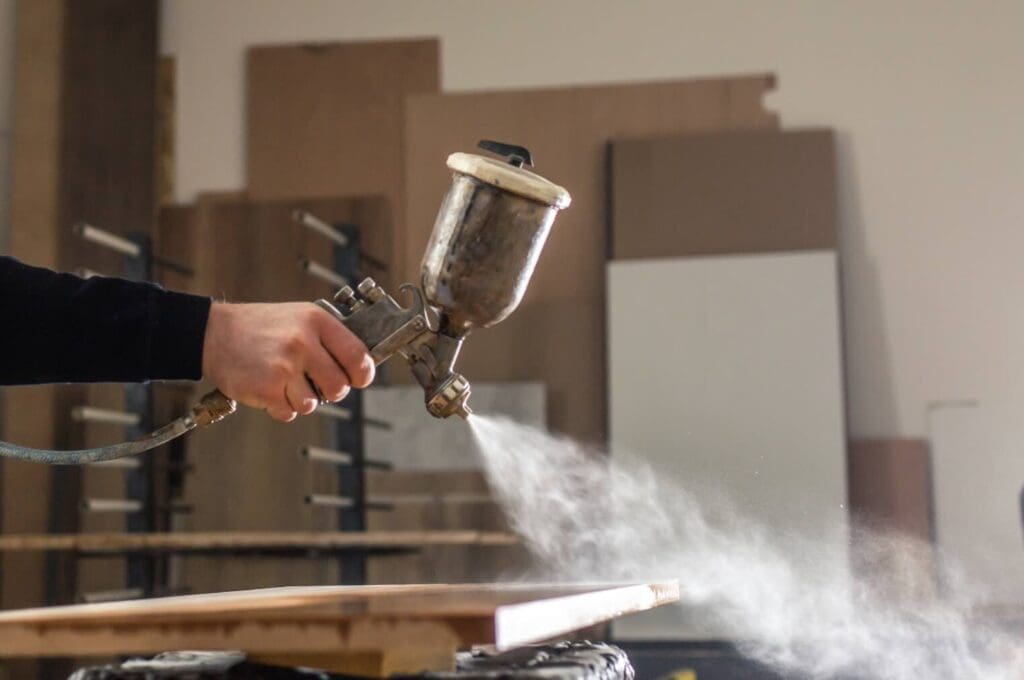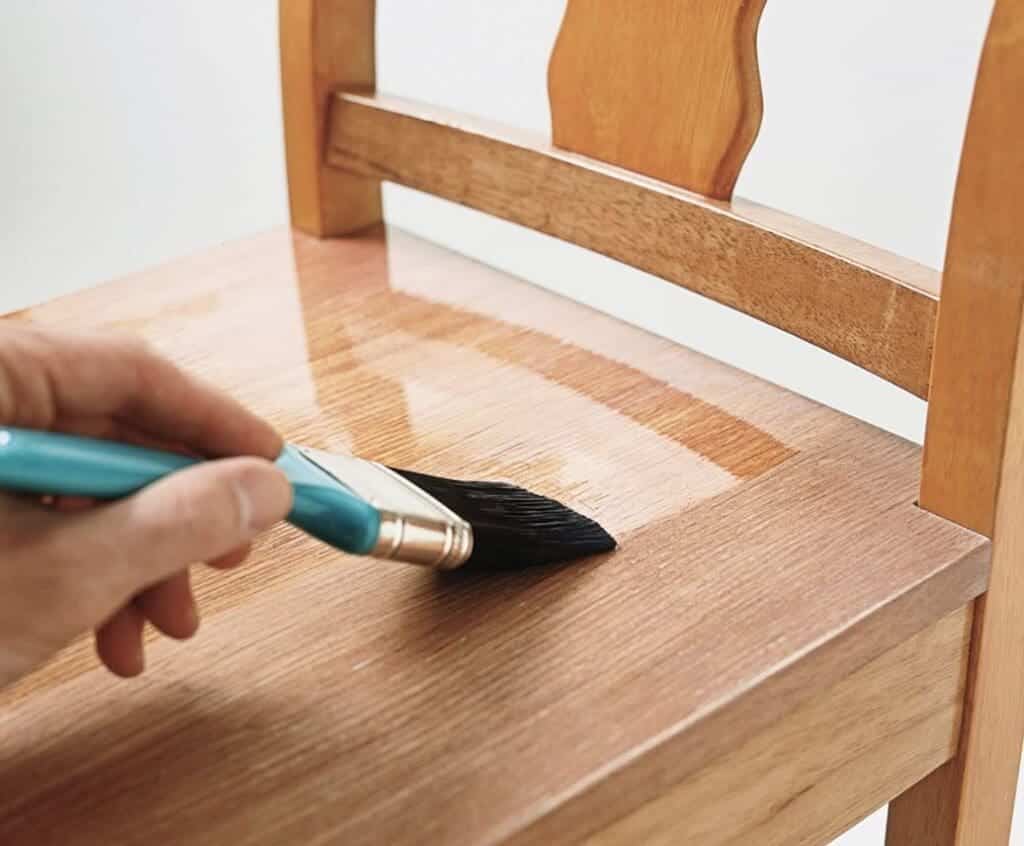As you glide your hand over the smooth surface of a finely crafted wooden table or admire the glossy finish on a vintage guitar, you’re likely experiencing the magic of a quality wood finish.
The final touch on any woodworking masterpiece isn’t just about aesthetics; it’s a crucial protective layer that determines the longevity and durability of the piece. Two contenders often steal the spotlight in wood finishes: lacquer and polyurethane. Each brings its charm and capabilities to the table, literally and figuratively.
Table of Contents
- Lacquer Vs. Polyurethane: Understanding The Finish
- Key Differences Between Lacquer And Polyurethane
- Summary: Lacquer Vs. Polyurethane
- Related Content
Lacquer Vs. Polyurethane: Understanding The Finish
When it comes to woodworking, the final finish showcases the craftsmanship and beauty of the wood. Lacquer and polyurethane are the most popular finishes, yet they are often misunderstood and interchangeable. Both have their unique characteristics, benefits, and challenges.
Read on as we delve into each finish, their differences, and how to choose the right one for your project.
What Is Lacquer?
Lacquer is a finish cherished by woodworkers for its user-friendly application and rapid drying time. This thinner finish gives wood furniture a seamless and lustrous appearance while maintaining durability.
One of the lacquer’s most compelling attributes is its ability to penetrate the wood’s surface, offering considerable damage resistance.

Application
For a flawless application, lacquer is best applied using a high-volume, low-pressure (HVLP) sprayer in a well-ventilated space.
Varieties Of Lacquer
Even among lacquer, there are different kinds of varieties. It is good to know and understand each of these.
Acrylic Lacquer:
Known for not yellowing like other finishes, acrylic lacquer leaves a crystal-clear finish. CAB-acrylic lacquer, a subtype, is less brittle and offers increased flexibility and scratch resistance, though it is more expensive.
Water-Based Lacquer:
With less toxicity, an absence of odor, and more excellent durability than many oil-based alternatives, water-based lacquer also boasts a longer lifespan—up to five additional years compared to nitrocellulose lacquer. It’s also more cost-effective and dries rapidly.
Nitrocellulose Lacquer:
Characterized by its fast-evaporating nature, this lacquer enhances wood’s color and forms a protective film. Though highly flammable, it is resistant to damage when appropriately applied.
Repairability Of Lacquer
Lacquer shines in repairability due to its thinness, which allows for easy blending with existing coats.
What Is Polyurethane?
Polyurethane is a sought-after wood finish that provides a robust, glossy coat. As a plastic in liquid form until dried, polyurethane offers a thick layer of protection that is not as quickly sprayed on as lacquer.

Variants Of Polyurethane
There are also different kinds of polyurethane, each with its uses. Read on as we explore two significant types of polyurethane.
Water-Based Polyurethane:
This variant is less toxic, faster-drying, does not leave a yellowish tinge on the wood, and is ideal for items not subjected to high heat.
Oil-Based Polyurethane:
Known for its resilience and ability to withstand heat, this type is slower to dry and has a strong odor. It’s commonly used on surfaces like kitchen tables where durability is paramount.
Application Of Polyurethane
Due to its viscosity, polyurethane typically requires a brush for application, making it more labor-intensive than lacquer.
Key Differences Between Lacquer And Polyurethane
While lacquer and polyurethane may appear comparable initially, essential distinctions set them apart.
Quality
Polyurethane generally offers more durability due to its thickness, forming a hard coating. Lacquer, while also durable, is prone to scratching and potential discoloration over time.
Ease Of Application
Lacquer wins in the ease of application with its suitability for spraying, allowing for an even finish. Polyurethane’s thick nature often leaves brush marks and requires a finer brush or a more skilled application to avoid these.
Dry Time
Polyurethane’s drying time is considerably longer, especially in the oil-based variety. Water-based polyurethane dries faster but not as quickly as lacquer, which can dry within minutes, allowing for multiple coats in a short time frame.
Multiple Coats
Applying multiple coats is straightforward with lacquer due to its quick drying and easy adherence to previous layers. Polyurethane requires more time to cure and may need sanding between coats for optimal adhesion.
Summary: Lacquer Vs. Polyurethane
- Polyurethane: Thicker, longer drying time, available in water and oil-based forms.
- Lacquer: Thinner, faster drying, available in acrylic, nitrocellulose, and water-based forms.
- Application: Due to quick drying times, lacquer is more straightforward to apply in multiple coats.
- Durability: Polyurethane forms a thicker, more durable coat, but lacquer can be more damage-resistant because it penetrates the wood.
Choosing The Right Finish
When selecting a finish for your woodworking project, consider the end use of the item, the desired aesthetics, and the working conditions. Lacquer could be your best bet for projects requiring quick turnaround and a flawless finish. In contrast, polyurethane may be the way for items needing a thick, protective coat.
In the end, lacquer and polyurethane are in the woodworker’s toolkit. By understanding the properties and applications of each, you can make an informed decision that brings out the best in your woodwork.
At Mondoro, we would love to help you decide which material would be best for manufacturing your home decor and furniture product.
Find out more about how Mondoro can help you create, develop, and manufacture excellent home decor and home furniture products – including lacquer furniture. Don’t hesitate to contact me, Anita. Check out my email by clicking here or become a part of our community and join our newsletter by clicking here.
Mondoro gives out a FREE Lookbook to anyone interested. You can receive a copy of our latest Lookbook by clicking here.
Listen to our Podcast called Global Trade Gal. You can find it on all major podcast platforms. Try out listening to one of our podcasts by clicking here.
Subscribe to our Mondoro Company Limited YouTube Channel filled with great videos and information by clicking here.
Related Content
Hardwood Solids Furniture, What Does The Term Mean?
Hardwood solids can include non-solid woods such as engineered woods. Hardwood solids are used in furniture and other industries to classify what wood is used in a product. The terms usually do not classify what type of wood is used.
You can discover more by reading Hardwood Solids Furniture, What Does The Term Mean? by clicking here.
Differences Between Solid Wood, Plywood, Pressboard, And OSB?
Solid wood is wood cut from a tree and made into products; plywoodred engineered wood. Pressboard is made from paper, including recycled paper. OSB is also known as Oriented Strand Board, and because of its strength is used a lot in roofing, housing, and floors.
You can discover more by reading our blog Differences Between Solid Wood, Plywood, Pressboard, And OSB? by clicking here.
What Is Solid Wood Vs. Engineered Wood?
Solid wood is cut down from the tree, cut into wood boards, and used for manufacturing. On the other hand, engineered wood is considered manmade as it is usually manufactured with wood chips, wood shavings, and an adhesive. Today the manufacturing of engineered wood is highly technical.
You can discover more by reading our blog All About Teak Wood And Outdod? by clicking here.

